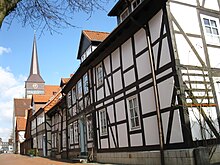Knollenstrasse
Coordinates: 52 ° 8 ′ 49.3 " N , 9 ° 57 ′ 14.5" E
Because of its well-preserved half-timbered houses, Knollenstrasse is one of the most frequently photographed streets in Hildesheim by tourists . It is located in the south of the city center in the Neustadt district .
Position and length
With a length of only 65 m, Knollenstrasse is one of the shortest streets in Hildesheim. The house numbers range from No. 1 to No. 13. It connects Keßlerstraße with Neustädter Markt and runs straight from north to south. The late Gothic parish church of St. Lamberti , which is also worth seeing, rises in the immediate vicinity .
origin of the name
The street already had its current name at the time of its first written mention (see below). It has been suggested on various occasions that it could refer to a specific family who lived here or who were to be honored by the naming of the street. It is more likely, however, that the - undoubtedly unusual - name stems from the shortness of the street and its dense development. On a map from 1767 the Knollenstrasse is marked as "Knorrenstrasse". Maybe this name was a typo. However, it cannot be ruled out that the street was actually called "Knorrenstraße" at times, because the Middle High German word knorre meant "knot-shaped thickening" or "outgrowth", which could well describe a "tuber": In the Middle Ages , the street might have looked like a bulge or extension of the Neustädter Markt . To this day there is still no consensus on the origin of the street name.
history
The Neustadt district of Hildesheim was laid out according to plan with straight, regular streets at the beginning of the 13th century and was first mentioned in a document in 1221. Knollenstrasse was first mentioned in writing as "Knollenstrate" in 1502 and was entered on a city map in 1767 with the name "Knorrenstrasse". During the Second World War , roofs and windows were damaged in an air raid on February 22, 1945. Knollenstrasse survived the heaviest air raid on Hildesheim on March 22, 1945, despite its central location almost unscathed.
Buildings and special features
Almost all the houses on Knollenstrasse are eaves , two to three- story half-timbered houses. The most striking of these is the house at Knollenstrasse No. 9, which - possibly as an arable bourgeois' house - was built in 1789 and raised another floor in 1897. In the middle you can still see the wide entrance to the hall. The house was built on a sandstone base and renovated in 1982.
In the entire Knollenstrasse - as in the neighboring Keßlerstrasse - the colorful, well-preserved front doors from the 19th and early 20th centuries are striking. The house at Knollenstrasse No. 2, also built on a sandstone plinth, is additionally decorated with a slogan on the facade above the ground floor. There is also a metal door knocker on his front door - it is reminiscent of a time when there were no bells.
Individual evidence
- ↑ Dr. Häger, Hartmut: Hildesheimer Straßen, p. 131. Hildesheim 2005.
- ↑ Dr. Zoder, Rudolf: Die Hildesheimer Strasse, p. 52. Hildesheim 1957.
- ↑ Segers-Glocke, Christiane: Baudenkmale in Niedersachsen, S. 160. Hameln 2007.
- ↑ Seeland, Hermann: Destruction and Downfall of Alt-Hildesheim , p. 10. Hildesheim 1947.
- ↑ Segers-Glocke, Christiane: Baudenkmale in Niedersachsen, p. 167. Hameln 2007.




